微观经济学-英文课程描述
微观经济学 英语
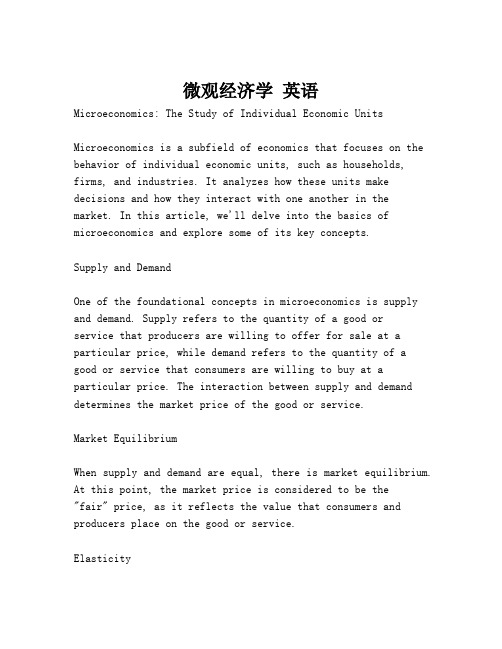
微观经济学英语Microeconomics: The Study of Individual Economic UnitsMicroeconomics is a subfield of economics that focuses on the behavior of individual economic units, such as households, firms, and industries. It analyzes how these units make decisions and how they interact with one another in the market. In this article, we'll delve into the basics of microeconomics and explore some of its key concepts.Supply and DemandOne of the foundational concepts in microeconomics is supply and demand. Supply refers to the quantity of a good orservice that producers are willing to offer for sale at a particular price, while demand refers to the quantity of a good or service that consumers are willing to buy at a particular price. The interaction between supply and demand determines the market price of the good or service.Market EquilibriumWhen supply and demand are equal, there is market equilibrium. At this point, the market price is considered to be the "fair" price, as it reflects the value that consumers and producers place on the good or service.ElasticityAnother important concept in microeconomics is elasticity. Elasticity measures the responsiveness of supply or demand to changes in price. For example, if the price of a good increases, and the quantity demanded of the good decreases significantly, then demand is considered to be elastic. If the quantity demanded changes little in response to a price change, then demand is considered to be inelastic.Profit MaximizationFirms in microeconomics seek to maximize their profits. This means that they will produce and sell goods and servicesuntil the marginal cost of production is equal to the marginal revenue that they earn from each additional unit sold.Market StructureFinally, microeconomics examines the different market structures that exist in the economy. These structures include perfect competition, monopolistic competition, oligopoly, and monopoly. Each structure has its own unique characteristics, such as the number of firms in the market, the degree of product differentiation, and the barriers to entry.ConclusionMicroeconomics is a fascinating field of study that provides insights into the behavior of individual economic units and how they interact in the market. By understanding theseconcepts, economists can analyze and predict the outcomes of various economic scenarios, and policymakers can design effective policies to promote economic growth and prosperity.。
微观经济学-曼昆英文版本

A Firm’s Long-Run Decision to Exit
• Cost of exiting the market: revenue loss = TR
• Benefit of exiting the market: cost savings = TC (zero FC in the long run) • So, firm exits if TR < TC
Because of 1 & 2, each buyer and seller is a
“price taker” – takes the price as given.
The Revenue of a Competitive Firm
• Total revenue (TR)
• Average revenue (AR)
Qa Q 1 Qb
Q
MC and the Firm’s Supply Decision
If price rises to P2, then the profitmaximizing quantity rises to Q2.
Costs MC P2 MR2 MR
The MC curve determines the firm’s Q at any price. P1 Hence,
Introduction: A Scenario
• Three years after graduating, you run your own business. • You must decide how much to produce, what price to charge, how many workers to hire, etc. • What factors should affect these decisions?
微观经济学课程简介英文模版

MicroeconomicsCourse Code: 62216000Course Name: MicroeconomicsCourse Credit: 4 Course Duration: The Second SemesterTeaching Object: All Majors in Business SchoolPre-course:CalculusCourse Director: Zuo Feng Associate Professor Master of EconomicsCourse Introduction:Microeconomics is the basis course of Economics and Management Major. The Microeconomics including equilibrium price theory, consumer behavior theory, producer behavior theory, market structure theory, the determination of prices of production factors and income distribution, general equilibrium theory, welfare economics, as well as micro-economic policy and so on. The aim of course is to enable students to master the basic theory of microeconomics comprehensivly and systematicly , to enable students to analysis and solve the problem, and to lay a solid foundation for an in-depth understanding of other economic and management courses.Practical Activities:Courses is taught mainly through classroom teaching, and provide considerable after-school exercise to help students digest and correctly understand the content of classroom lectures.Course Examination:Students’ Final Scores = Scores of Ordinary Tests * 30% + Scores of the Final Exam * 70% Scores of ordinary tests vary according to students’performance in attendance, homework and practical activities.The final exam will be an close-book exam.Appointed Teaching Materials:[1]Gao HongYe. Economics (Microeconomics). Beijing: China Ren Min University Press ,2007,Fourth Edition.Bibliography:[1]Zhu ShanLi. Microeconomics. Beijing: Peking University Press ,2007, Third Edition.[2]zhang yuanpeng. Microeconomics .Beijing: Peking University Press ,China EconomyPress,2002.[3] R.S.Pindyck, D.L.Rubinfeld. Microeconomics .Beijing: China Ren Min University Press ,2006,Sixth Edition .[4] Paul Samuelson,William Nordhaus.Economics.Beijing:Post & Telecom Press,2008, Eighteenth Edition.。
微观经济学英文教材

微观经济学英文教材In the realm of economics, microeconomics stands as a foundational pillar, delving into the intricate interplay of individual decision-making, market forces, and resource allocation. As an indispensable tool for understanding the behavior of consumers, producers, and the dynamics of supply and demand, a comprehensive English textbook on microeconomics becomes an invaluable asset for students and scholars alike. This text aims to provide a comprehensive exploration of the core concepts, theoretical frameworks, and practical applications that shape the ever-evolving landscape of microeconomics.Drawing from a wealth of scholarly research and real-world examples, this textbook offers a multifaceted perspective on the decision-making processes of economic agents, shedding light on their motivations, constraints, and the consequences of their choices. It meticulously dissects the role of utility maximization in consumer behavior, unveiling the intricacies of indifference curves, budget constraints, and the intricate dance between preferences and resource allocation. Furthermore, it delves into the realm of production theory, examining the factors that influence firm behavior, cost minimization strategies, and the pursuit of profit maximization.The text also explores the intricate dynamics of market structures, from the idealized realms of perfect competition to the complexities of imperfect competition, monopolies, and oligopolies. It illuminates the mechanisms that govern pricing strategies, market entry and exit decisions, and the delicate balance between efficiency and equity. Additionally, it tackles the multifaceted dimensions of market failures, externalities, and the role of government intervention through policies and regulations.Moreover, this textbook embraces a global perspective, recognizing the interconnected nature of modern economies. It examines the intricate web of international trade, the impact of globalization on domestic markets, and the challenges posed by cross-border economic activities. By integrating theoretical concepts with empirical evidence and case studies, this text empowers readers to grasp the practical implications of microeconomic principles in diverse real-world contexts.Throughout its chapters, this English microeconomics textbook emphasizes the importance of critical thinking, quantitative analysis, and the application of mathematical models to facilitate decision-making processes. It equips readers with the analytical tools necessary to navigate the complexities of resource allocation, market equilibrium, and the intricate interplay between economic agents. Byfostering a deep understanding of microeconomic principles, this text empowers individuals to make informed decisions, evaluate public policies, and contribute to the ongoing discourse on economic efficiency and societal well-being.Ultimately, this comprehensive English textbook on microeconomics serves as an invaluable resource for students, educators, and professionals alike, offering a gateway to the fascinating world of individual decision-making, market dynamics, and the intricate tapestry of economic interactions that shape our modern world.。
微观经济学的英语
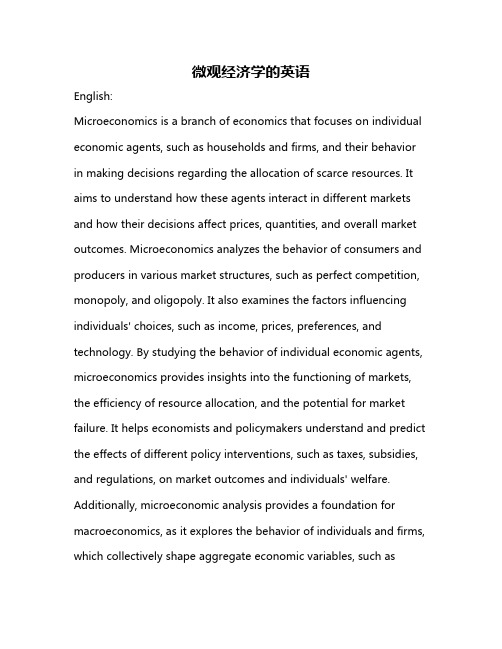
微观经济学的英语English:Microeconomics is a branch of economics that focuses on individual economic agents, such as households and firms, and their behavior in making decisions regarding the allocation of scarce resources. It aims to understand how these agents interact in different markets and how their decisions affect prices, quantities, and overall market outcomes. Microeconomics analyzes the behavior of consumers and producers in various market structures, such as perfect competition, monopoly, and oligopoly. It also examines the factors influencing individuals' choices, such as income, prices, preferences, and technology. By studying the behavior of individual economic agents, microeconomics provides insights into the functioning of markets, the efficiency of resource allocation, and the potential for market failure. It helps economists and policymakers understand and predict the effects of different policy interventions, such as taxes, subsidies, and regulations, on market outcomes and individuals' welfare. Additionally, microeconomic analysis provides a foundation for macroeconomics, as it explores the behavior of individuals and firms, which collectively shape aggregate economic variables, such asnational income, employment levels, and inflation. Overall, microeconomics provides the framework to comprehend the decision-making processes of economic agents and their implications for resource allocation and overall economic performance.中文翻译:微观经济学是经济学的一个分支,专注于个体经济主体,如家庭和企业,以及它们在稀缺资源的分配方面作出决策的行为。
微观经济学英文课件

Edited by Yong, E.L.
Continuously,
Microeconomics is also used for evaluating broad question in regards to government policy (although this is more to macroeconomics).
Edited by Yong, E.L.
Continuously,
If the firm produces 6 units of apple and 12 units of apple pie wants to increase the production of apple pie by one unit to the 13th unit. It has to forgo 2 units of apple so that resources can be shifted to produce the additional apple pie; Opportunity Cost is thus 2.
Edited by Yong, E.L.
Continuously,
If the firm produces 10 units of apple and 6 units of apple pie wants to increase the production of apple pie by one unit to the 7th unit. It has to forgo 1 unit of apple so that resources can be shifted to produce the additional apple pie; Opportunity Cost is thus 1.
中级微观经济学课程简介英文模版

Intermediate MicroeconomicsCourse Code: 62216002Course Name: Intermediate MicroeconomicsCourse Credit: 4Course Duration: 7Teaching Object: Senior undergraduate of Business DepartmentPre-course: Basic MicroeconomicsCourse Director: Guo JianQiang Associate Professor Ph.D. of EconomicsCourse Introduction:Unrivaled in Its Unique Combination of Analytical Rigor and Accessibility, Intermediate Microeconomics: A Modern Approach Has Gained One of the Broadest Adoption Lists in the Market. Now Appearing in Its Sixth Edition, Professor V arian's hallmark Text Is Better than Ever, Featuring New Treatments of Game Theory and Competitive Strategy, and A Variety of New Illustrative Examples. Modern, Authoritative, and above All Crafted by An Outstanding Teacher and Scholar, Intermediate Microeconomics, Sixth Edition Will Expand Students' Analytic Powers and Strengthen Their Understanding of Microeconomics.Course Examination:Students’ Final Scores = Scores of Ordinary Tests * 10% + Scores of the Final Exam * 90% Scores of ordinary tests vary according to students’ performance in attendance, homework and practical activities.The final exam will be an closed-book exam.Appointed Teaching Materials:Textbook: Hal R. Varian, Intermediate Microeconomics: A Modern Approach (Sixth Edition), W. W. Norton, 2003.Answers to Workouts of this course (PDF) Offered by Teacher.Bibliography:[1]Hal R. Varian, Intermediate Microeconomics: A Modern Approach (Sixth Edition),W.W.Norton,2003.[2]James M. Henderson and R. E. Quandt, Microeconomic Theory A Mathematical Approach,McGraw-Hill Book Co. 1980.[3]Waiter Nichoson, Microeconomic Theory: Basic Principles and Extension, 8th Edition,SouthWestern 2002.。
《微观经济学》课程教学大纲
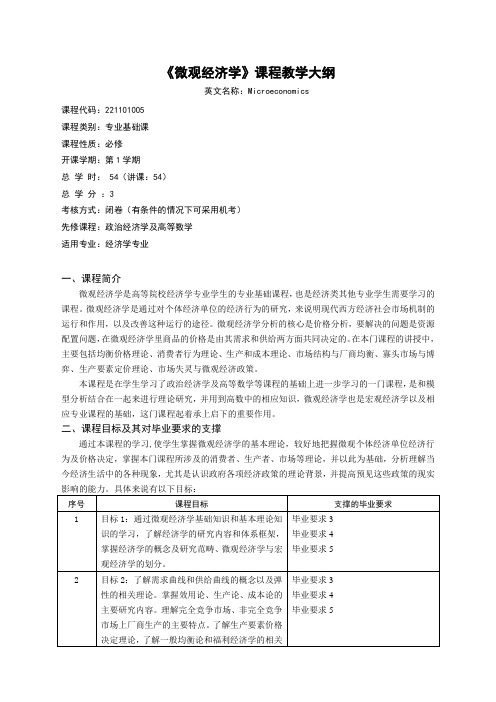
《微观经济学》课程教学大纲英文名称:Microeconomics课程代码:221101005课程类别:专业基础课课程性质:必修开课学期:第1学期总学时: 54(讲课:54)总学分:3考核方式:闭卷(有条件的情况下可采用机考)先修课程:政治经济学及高等数学适用专业:经济学专业一、课程简介微观经济学是高等院校经济学专业学生的专业基础课程,也是经济类其他专业学生需要学习的课程。
微观经济学是通过对个体经济单位的经济行为的研究,来说明现代西方经济社会市场机制的运行和作用,以及改善这种运行的途径。
微观经济学分析的核心是价格分析,要解决的问题是资源配置问题,在微观经济学里商品的价格是由其需求和供给两方面共同决定的。
在本门课程的讲授中,主要包括均衡价格理论、消费者行为理论、生产和成本理论、市场结构与厂商均衡、寡头市场与博弈、生产要素定价理论、市场失灵与微观经济政策。
本课程是在学生学习了政治经济学及高等数学等课程的基础上进一步学习的一门课程,是和模型分析结合在一起来进行理论研究,并用到高数中的相应知识,微观经济学也是宏观经济学以及相应专业课程的基础,这门课程起着承上启下的重要作用。
二、课程目标及其对毕业要求的支撑通过本课程的学习,使学生掌握微观经济学的基本理论,较好地把握微观个体经济单位经济行为及价格决定,掌握本门课程所涉及的消费者、生产者、市场等理论,并以此为基础,分析理解当今经济生活中的各种现象,尤其是认识政府各项经济政策的理论背景,并提高预见这些政策的现实三、课程内容及要求第一章引论教学内容:第一节什么是西方经济学第二节现代西方经济学的由来和演变第三节正确对待西方经济学第四节有关学习西方经济学的几点建议学生学习预期成果:了解西方经济学的研究内容、研究对象、由来和演变,理解实证经济学与规范经济学的区别,掌握微观经济学与宏观经济学的区别与联系。
教学重点:西方经济学研究的对象是资源配置与资源利用问题;微观经济学与宏观经济学的区别与联系;实证经济学与规范经济学的区别。
微观经济学英文版第一章

理论和模型 Theories and Models
微观经济分析 Microeconomic Analysis
理论的演变 Evolving the Theory 检验和修正是经济科学发展的中心. Testing and refining theories is central to the development of the science of economics. 观察→检验→修正或完善,甚至是抛弃
Slide 5
关于教材的特点
特点二:内容组织合理、富有挑战性,令 人收益菲浅。
特点三:强调有用性,密切联系实际,穿插 80多个具体的案例分析,融合于全书之 中,帮助理解经济学基本理论和方法。
本书的两位作者都是著名经济学家,很多案 例都取材于计量经济学研究论文的内容,有 理有据。
Slide 6
本原理—加深理解在入门课程学过 的微观经济学
Slide 10
第一章 Chapter 1
绪论Preliminaries
概论微观经济学
稀缺、权衡取舍、经济模型与决策、竞争 性市场(I和II)与非竞争性市场(III和IV)的区 别
Slide 11
讨论的题目 Topics to be Discussed
Slide 30
实证分析 Positive Analysis
例如: For example: 进口配额对进口汽车有什么样的影响? What will be the impact of an import quota on foreign cars? 提高汽油税有什么样的影响? What will be the impact of an increase in the gasoline excise tax?
(完整版)《微观经济学》课程教学大纲
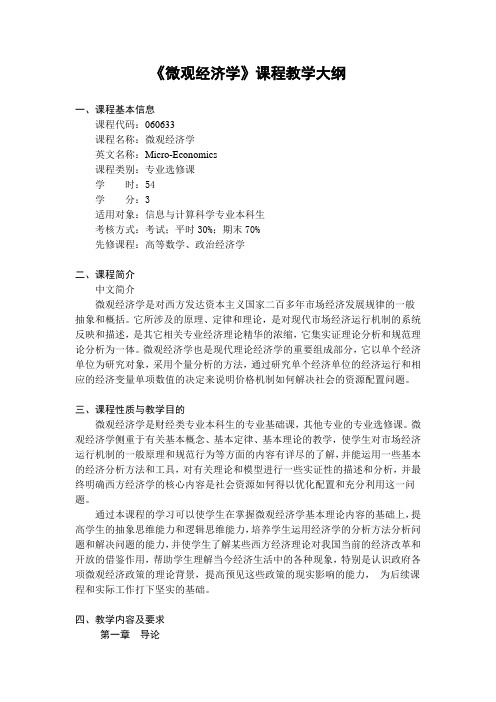
《微观经济学》课程教学大纲一、课程基本信息课程代码:060633课程名称:微观经济学英文名称:Micro-Economics课程类别:专业选修课学时:54学分:3适用对象:信息与计算科学专业本科生考核方式:考试;平时30%;期末70%先修课程:高等数学、政治经济学二、课程简介中文简介微观经济学是对西方发达资本主义国家二百多年市场经济发展规律的一般抽象和概括。
它所涉及的原理、定律和理论,是对现代市场经济运行机制的系统反映和描述,是其它相关专业经济理论精华的浓缩,它集实证理论分析和规范理论分析为一体。
微观经济学也是现代理论经济学的重要组成部分,它以单个经济单位为研究对象,采用个量分析的方法,通过研究单个经济单位的经济运行和相应的经济变量单项数值的决定来说明价格机制如何解决社会的资源配置问题。
三、课程性质与教学目的微观经济学是财经类专业本科生的专业基础课,其他专业的专业选修课。
微观经济学侧重于有关基本概念、基本定律、基本理论的教学,使学生对市场经济运行机制的一般原理和规范行为等方面的内容有详尽的了解,并能运用一些基本的经济分析方法和工具,对有关理论和模型进行一些实证性的描述和分析,并最终明确西方经济学的核心内容是社会资源如何得以优化配置和充分利用这一问题。
通过本课程的学习可以使学生在掌握微观经济学基本理论内容的基础上,提高学生的抽象思维能力和逻辑思维能力,培养学生运用经济学的分析方法分析问题和解决问题的能力,并使学生了解某些西方经济理论对我国当前的经济改革和开放的借鉴作用,帮助学生理解当今经济生活中的各种现象,特别是认识政府各项微观经济政策的理论背景,提高预见这些政策的现实影响的能力,为后续课程和实际工作打下坚实的基础。
四、教学内容及要求第一章导论(一)目的与要求1.了解西方经济学的研究对象和基本内容;2.掌握微观经济学与宏观经济学的含义;3.掌握微观经济学中的实证分析与规范分析;4.了解西方经济学的研究方法,掌握静态分析、比较静态分析和动态分析方法。
微观经济学英文版
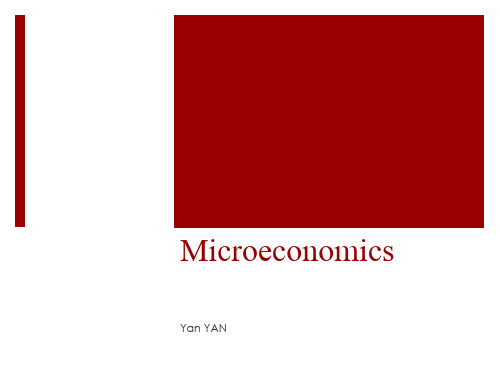
Chapter 1: The Fundamentals of Economics(A. Introduction)
1.1 Scarcity and Efficiency
What is economics ?
Economics is the study of how societies use scarce resources to produce valuable commodities and distribute them among different people.
Microeconomics
Yan YAN
Chapter 1: The Fundamentals of Economics(A. Introduction)
You want to buy a clock in the grocery near the campus. The price is $20. A friend tells you that it is $10 in the supermarket in downtown. Would you buy the clock in the supermarket?
1) plot the straight-line relationship between all combinations of X and Y on a blank piece of graph paper.
2)let us say that you absolutely need 6 hours of leisure per day, no more, no less. On the graph, mark the point that corresponds to 6hours of leisure.
《微观经济学》课程教学大纲

《微观经济学》课程教学大纲课程代码:020*******课程名称:微观经济学英文名称:microeconomics学分:3总学时:48讲课学时:48实验学时:上机学时:课外学时:60适用对象:国贸经济与贸易专业先修课程:高等数学、学生自主学习时数建议:—、课程性质、目的和任务本课程是国家教育部指定的本科院校财经类各专业的核心课程之一,是经济学科的专业基础课程,在财经类院校或专业的教学中具有重要的地位。
微观经济学是现代西方经济理论的重要构成部分,微观经济学以单个经济单位为考察对象,通过对单个经济单位的经济行为的研究,说明现代经济社会市场机制的运行和作用,以及改善这种运行的途径。
价格分析是微观经济学的核心,供给、需求及其与价格的关系的论述成为微观经济学分析的出发点,在此基础上,进一步构建了消费者行为理论、生产者行为理论、生产要素价格决定及收入分配理论、一般均衡论和社会福利理论、微观政策调节理论等完善的微观经济学理论体系。
二、教学基本要求通过微观经济学的学习,不仅要使学生对市场运行的一般规律、对实现资源配置的基础条件、对市场失灵及其矫正等理论有完整的了解,更应引导学生科学认识、分析、评价微观经济学理论,并力求能够理论与实际结合,提高分析问题、解决问题的能力。
基本要求如下:1.理解经济学的十大原理。
掌握经济学研究方法。
2.掌握需求、供给和弹性理论,并能灵活运用理论分析实际问题。
3.理解市场效率的衡量方法,分析赋税的代价。
4.理解外部性问题及针对外部性的公共政策,理解公共物品和公共资源。
5.掌握生产理论和成本理论,理解厂商是如何进行生产决策的。
6.理解四种类型市场的特征,各种类型市场的短期均衡和长期均衡。
7 .理解要素市场上各种要素价格的决定及要素之间的关系。
8.理解消费者选择的最优化问题。
三' 教学内容第一单元经济学十大原理1、教学内容(1)理解人们如何做出决策(2)理解人们如何相互交易(3)理解整体经济如何运行2、重点和难点(1)重点:人们如何做出决策,人们如何相互交易(2)难点:整体经济如何运行第二单元像经济学家一样思考1、教学内容(1)理解经济学研究方法(2)掌握实证分析与规范分析的区别2、重点和难点(1)重点:实证分析与规范分析的区别(2)难点:经济学研究方法第三单元供给与需求的市场力量1、教学内容(1)理解市场类型及竞争。
微观经济学 英文课程描述
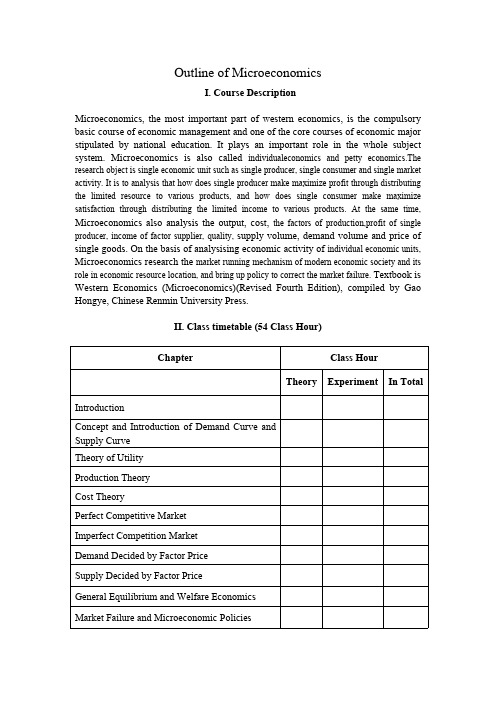
II. Class timetable (54 Class Hour)
Chapter
Class Hour
Theory Experiment In Total
Introduction Concept and Introduction of Demand Curve and Supply Curve Theory of Utility Production Theory Cost Theory Perfect Competitive Market Imperfect Competition Market Demand Decided by Factor Price Supply Decided by Factor Price General Equilibrium and Welfare Economics Market Failure and Microeconomic Policies
《微观经济学》课程教学大纲

《微观经济学》课程教学大纲一、课程基本信息课程代码:16143103课程名称:西方经济学(微观部分)英文名称:Microeconomics课程类型:学科基础课学时:48学时学分:3学分适应对象:全院经济管理类各本科专业考核方式:考试先修课程:高等数学二、课程简介中文简介:(附内容结构图)微观经济学研究单个经济单位的活动规律。
具体地说,微观经济学研究单个消费者、单个生产者、单个市场的的经济行为,其对单个经济单位的考察,是在三个逐步深入的层次上进行:第一层次考察单个消费者、单个生产者的均衡;第二层次考察单个的市场均衡;第三层次考察所有单个市场均衡价格的决定。
正因为其分析涉及的变量都是经济个量,它才被称为微观经济学。
价格分析是微观经济学分析的核心,微观经济学也被称为价格理论。
本书关于价格理论的讲述是按以下层次展开:开篇简介西方经济学;第二章介绍价格的确定是由于供需两种因素均衡的结果,当然,作为必备知识,本章也介绍了供给、需求函数及相关曲线、供求的各种弹性;第三章介绍了决定商品价格的需求因素,需求曲线之所以向右下方倾斜,是由于效用最大化原则的要求;为说明供给曲线,第四章、第五章介绍了生产函数和成本函数,得到了一定产量时厂商成本最小化的条件和长短期成本曲线。
通过第六章的学习,可以得到完全竞争的市场条件下,厂商的商品供给曲线即是其边际成本线(高于平均可变成本最低点以上部分)。
第七章介绍了三种不完全竞争市场条件下都不存在规律的供给曲线。
至此,商品的供求及价格决定的内容已完整。
第八章、第九章介绍了要素的供求,从而确定了要素均衡时的价格。
第十章将单个市场均衡推广到多个市场,并讨论了生产和交换的最优条件;第十一章则从价格失灵的角度讨论其失灵原因及相应的对策。
英文简介:The conomics behaviors of single unit are studies in the subject of Microeconomics.In details,a cosumer、a poductor or a market is studied.Three contends are included in the book.The first one describes the conomics equilibrium behaviors of single cosumer andsingle cosumer;the second part explains how some market turning equilibrium;the equilibrium price and quantity of all markets was discussed in the third one.Because single unit is discussed,the subject was called as Microeconomics.The price analyses is the core of Microeconomics.What is Economics is introduced in the first chaptes;how the price deing decided is explained in the second chapter;demanding is described in the third;how to get supply curve is the main contend from the fourthchapter to the seventh one.The discussion about the factors demand and supply was introduced.The contend of the tenth chapter is market equilibrium and the production optimization and exchange optimization;Externalities、public goods、asymmetric information and Microeconomics policy are discussed in the eleventh.微观经济学内容结构图第一章:引论第四章:生产论第三章:效用论第二章:需求曲线和供给曲线概述以及有关的基本概念第十章:一般均衡论和福利经济学第九章:生产要素价格决定的供给方面第五章:成本论第六章:完全竞争市场第七章:不完全竞争市场第八章:生产要素价格决定的需求方面第十一章:市场失灵和微观经济政策在本课程体系中的功能章次及内容简介“西方经济学”范畴价格的形成机制——供求均衡的结果商品需求曲线的形成:消费者效用最大化的结果完全竞争时商品供给曲线的形成:生产者利润最大化的结果生产函数成本函数利润最大化条件不完全竞争条件下无有规律的商品供给曲线商品价格的形成:供求均衡生产要素的需求因素:边际要素收益=边际要素成本生产要素的供给因素:要素自用效用=要素供给效用所有市场的均衡价要素价格的形成:供求均衡价格失灵,不能起资源调配作用,采用相关经济政策生产和交换的最优条件实证经济学规范经济学三、课程性质与教学目的课程性质:作为西方经济学的组成部分,微观经济学是对西方发达资本主义国家二百多年市场经济发展中的单个经济单位活动规律的一般抽象和概括。
经济学微观英文版第三版课程设计 (2)

经济学微观英文版第三版课程设计
课程描述
本课程是经济学微观英文版第三版的设计与讲解。
经济学微观英文版是一门研究人们作为消费者与生产者的决策与交换行为的学科。
学习本课程后,学生将具备一定的微观经济学基础知识和分析技能,能够在实际生活和工作中应对各种经济问题。
课程目标
•熟悉微观经济学中的常用概念和理论。
•掌握微观经济学中的分析方法和技能。
•能够将微观经济学的知识应用于实际生活和工作中解决经济问题。
教学大纲
本课程将分为以下内容:
1.Introduction to Microeconomics
–Definition and scope of microeconomics
–Basic economic concepts: scarcity, choice, and
opportunity cost
–Basic economic models: production possibilities frontier and circular flow diagram
2.Supply and Demand
–Demand: law of demand, demand curve, determinants of demand
–Supply: law of supply, supply curve, determinants of supply
1。
微观经济学 英文简介
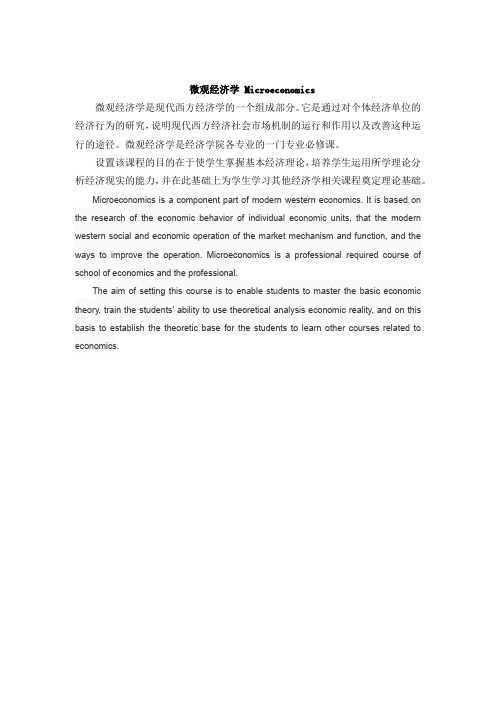
微观经济学 Microeconomics微观经济学是现代西方经济学的一个组成部分。
它是通过对个体经济单位的经济行为的研究,说明现代西方经济社会市场机制的运行和作用以及改善这种运行的途径。
微观经济学是经济学院各专业的一门专业必修课。
设置该课程的目的在于使学生掌握基本经济理论,培养学生运用所学理论分析经济现实的能力,并在此基础上为学生学习其他经济学相关课程奠定理论基础。
Microeconomics is a component part of modern western economics. It is based on the research of the economic behavior of individual economic units, that the modern western social and economic operation of the market mechanism and function, and the ways to improve the operation. Microeconomics is a professional required course of school of economics and the professional.The aim of setting this course is to enable students to master the basic economic theory, train the students' ability to use theoretical analysis economic reality, and on this basis to establish the theoretic base for the students to learn other courses related to economics.。
《微观经济学microeconomics》英文版
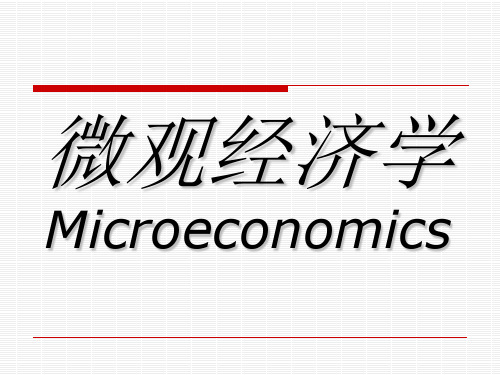
Expenditure Minimization Problem
The problem:
Minx0 px
s.t. u(x) u
The first order condition:
u( x* ) / xl u( x* ) / xk
pl pk
u( x) u
The solution: Hicksian demand function h(p,u)
ECON501 Lecture Note 3
Consumer Theory 2 ( Textbook Chapter 3 )
Structure
Utility Maximization Problem Utility maximization Walrasian demand function Indirect utility function
of demand Preference (Chapter 3) The basic properties of preference Existence of utility function
The Budget set
Commodities The physical constraints and the consumption set
Convexity of Walrasian budget set: proof
Consumer’s Choice
The consumer’s problem: to choose a consumption bundle x from the Walrasian budget set.
Walrasian Demand Function x( p, w)
Intuition: Figure 2.F.1
《微观经济学》教学大纲(英文版)
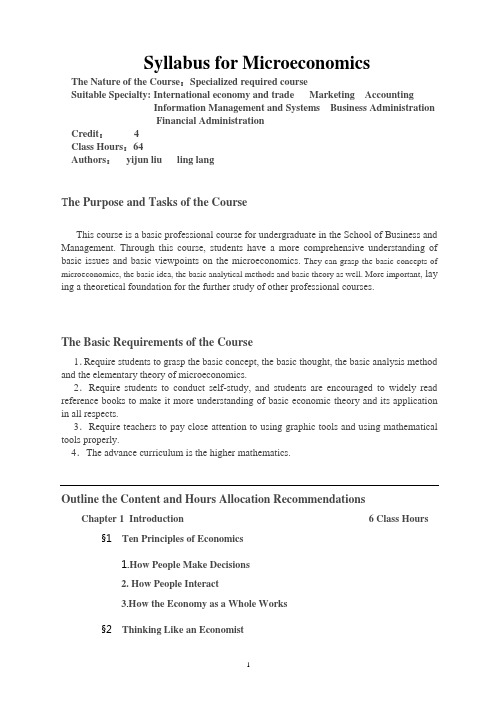
Syllabus for MicroeconomicsThe Nature of the Course:Specialized required courseSuitable Specialty: International economy and trade Marketing AccountingInformation Management and Systems Business AdministrationFinancial AdministrationCredit: 4Class Hours:64Authors:yijun liu ling langT he Purpose and Tasks of the CourseThis course is a basic professional course for undergraduate in the School of Business and Management. Through this course, students have a more comprehensive understanding of basic issues and basic viewpoints on the microeconomics. They can grasp the basic concepts of microeconomics, the basic idea, the basic analytical methods and basic theory as well. More important, lay ing a theoretical foundation for the further study of other professional courses.The Basic Requirements of the Course1.Require students to grasp the basic concept, the basic thought, the basic analysis method and the elementary theory of microeconomics.2.Require students to conduct self-study, and students are encouraged to widely read reference books to make it more understanding of basic economic theory and its application in all respects.3.Require teachers to pay close attention to using graphic tools and using mathematical tools properly.4.The advance curriculum is the higher mathematics.Outline the Content and Hours Allocation Recommendations Chapter 1Introduction 6 Class Hours §1 Ten Principles of Economics1.How People Make Decisions2. How People Interact3.How the Economy as a Whole Works§2 Thinking Like an Economist1.The Economist as a Scientist2. The Economist as a Policy Adviser3.Why Economist Disagree§3 the Using of Graphs in Economics (#)1.Graphic Drawing and Graphics Type in Economic Analysis2.Slope and Elasticity3. Note for Graphics Use in Economic Analysis§4 Interdependence and the Gains from Trade1.The Production Possibilities Frontier、Specialization and Tradeparative Advantage3.Applications of Comparative AdvantageChapter 2Supply and Demand(Ⅰ):How Markets Work 8 Class Hours §1Markets and Competitionpetitive Market2.Other Markets§2 law of demand1.Demand and the Demand Curve2.Shifts in the Demand Curve and Shift of the Demand Curve3.Market Demand and Individual Demand§3 law of supply (#)1. Supply and the Supply Curve2. Shifts in the Supply Curve and Shift of the Supply Curve3.Market Supply and Individual Supply§4 Supply and Demand Model1.The Conditions of Supply and Demand Model2.Supply and Demand Model3.What happens to equilibrium when supply and demand shifts?4.Cobweb Theory (☆)§5Elasticity and The Applications of Elasticity Theory1.the Elasticity of Demand and Its Application2.the Elasticity of Supply and Its Application(#)§6Supply、Demand and Government Policies1.Controls on prices (#)2.How Taxes Affect Market Outcomes3.Can Good News for Farming Be Bad News for Farmers?Exercise classes 2Class Hours Chapter 3 Supply and Demand(Ⅱ):Market and Welfare 16 Class Hours §1 The Theory of Consumer Choice 4 Class Hours1.Cardinal Utility Theory2. Preference Theory3.Application of The Theory of Consumer Choice§2 The Theory of Producer Choice 6 Class Hours1.The Organization of Production (#)2. Production Function and Factor Inputs3. The Cost Theory§3 Consumer Surplus 2Class Hours1.Willingness to Paying the Demand Curve to Measure Consumer Surplus3.How a Lower Price Raises Consumer Surplus§4 Producer Surplus(#)1.Cost and the Willingness to Sell2. Using the Supply Curve to Measure Producer Surplus3. How a Higher Price Raises Producer Surplus§5 Market Efficiency 2 Class Hours1.The Concept of Efficiency2.The Equilibrium Efficiency of the Competitive Firm(1)3.The conditions of the Efficient Competitive Firm§6 Application:The Cost of Taxation 2 Class Hours1.The Deadweight Loss of Taxation2.The Determinants of the Deadweight Loss3. Deadweight Loss and Tax Revenue as Taxes Vary§7 Application:International Trade (#)1.The Determinants of Trade2.The Winners and Losers from Trade3.The Arguments for Restricting TradeExercise classes 3 Class Hours Discussion class 1 Class Hour Chapter 4The Economics of the Public Sector 4 Class Hours §1 Externalities1.Externalities and Market Inefficiency2.Private Solutions to Externalities3.Public Policies toward Externalities§2 Public Goods and Common Resources1.The Different Kinds of Goods2.Public Goodsmon Resources§3 The Design of the Tax System(#)1.Taxes and Efficiency2.Taxes and EquityChapter 5 Supply and Demand(Ⅲ):Enterprise behavior and industrial organization8 Class Hours§1Types of Market (#)§2 Firms in Competitive Markets 4 Class Hours1. The Demand Curve and Revenue Curve of the Competitive Firm2. The Short-run Decision and the Supply Curve of the Competitive Firm3. The Short-run Supply Curve of the Competitive Market4.The Competitive Firm's Long-run Decision5.The Long-run Supply Curve of the Competitive Firm6.The Equilibrium Efficiency of the Competitive Firm(2)§3 Monopoly 4 Class Hours1.Why Monopolies Arise2.The Demand Curve and Revenue Curve of the Monopolistic Firm3.The Monopolistic Firm's Short-run and Long-run Decision4.The Welfare Cost of Monopoly5.Public Policy toward Monopolies6.Price Discrimination§4 Oligopoly (#)1.Markets with Only a few Sellers2.Game Theory and the Economics of Cooperation3.Public Policy toward Oligopolies§5 Monopolistic Competition(#)1.The Demand Curve and Revenue Curve of The MonopolisticCompetitive Firm2. The Monopolistic Competitive Firm in the Short-run and Long-run3. Monopolistic Competition and the Welfare of Society4.AdvertisingExercise classes 1 Class Hour Discussion class 1 Class Hour Chapter 6 Supply and Demand(Ⅳ):The Markets for the factors of production6 Class Hours§1 How Markets Determine Incomes1. Income and Wealth (#)2. Marginal Productivity Determines the Prices of Inputs§2 The Economics of Labor Market1.The Demand and Supply for Labor (#)2.Equilibrium in the Labor Market (#)3. Some Determinants of Equilibrium Wages4.The Economics of Discrimination§3 The Land Market and The Capital Marketnd and Rent2.Capital and Interest§4 Income Distribution (#)1.The Measurement of Inequality2.The Political Philosophy of Redistributing Income3.Policies to Reduce PovertyDiscussion class 2 Class Hours Chapter 7 Supply and Demand(Ⅴ):(General equilibrium) Market and Welfare (☆)§1 General equilibrium1.Meaning of the Equilibrium2. The Equilibrium Model of Léon Walras3. The Two-sector Model of General Equilibrium§2 Welfare Economics1.The Social Welfare Function2.Equity and EfficiencyChapter 8Uncertainty and Information (☆)§1 Uncertainty in the Economy1. Uncertainties and Risks2. The Effectiveness of Property3. Measurement of Risk Cost§2 Information, Risk and Markets1. Insurance and Risk-sharing2. Private Information and Market3. Risk Management in the Financial MarketsReview class 2 Class Hours Flexible time 4 Class Hours note:(#)Expressed that students learn these contents on its own, and they are included in the scope of examination.(☆)Expressed that students can choose according to their interest in reading, but not included in the scope of examination.Recommended Teaching Materials and Major Reference Books1.[美]曼昆著,梁小民译,《经济学原理(第5版)》,机械工业出版社,2009年2.[美]保罗·萨缪尔森、威廉·诺德豪斯著,萧琛主译,《经济学(第18版)》,人民邮电出版社,2008年3.刘毅军主编,《经济学基础》,石油工业出版社,2006年。
- 1、下载文档前请自行甄别文档内容的完整性,平台不提供额外的编辑、内容补充、找答案等附加服务。
- 2、"仅部分预览"的文档,不可在线预览部分如存在完整性等问题,可反馈申请退款(可完整预览的文档不适用该条件!)。
- 3、如文档侵犯您的权益,请联系客服反馈,我们会尽快为您处理(人工客服工作时间:9:00-18:30)。
Outline of Microeconomics
I. Course Description
Microeconomics, the most important part of western economics, is the compulsory basic course of economic management and one of the core courses of economic major stipulated by national education. It plays an important role in the whole subject system. Microeconomics is also called individualeconomics and petty economics.The research object is single economic unit such as single producer, single consumer and single market activity. It is to analysis that how does single producer make maximize profit through distributing the limited resource to various products, and how does single consumer make maximize satisfaction through distributing the limited income to various products. At the same time, Microeconomics also analysis the output, cost, the factors of production,profit of single producer, income of factor supplier, quality, supply volume, demand volume and price of single goods. On the basis of analysising economic activity of individual economic units, Microeconomics research the market running mechanism of modern economic society and its role in economic resource location, and bring up policy to correct the market failure. Textbook is Western Economics (Microeconomics)(Revised Fourth Edition), compiled by Gao Hongye, Chinese Renmin University Press.
II. Class timetable (54 Class Hour)。
